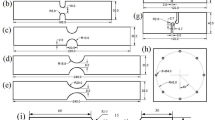Abstract
Cast aluminum alloys are increasingly being used in key parts of automobiles. Establishing a failure model that is suitable for aluminum alloy castings is vital for vehicle collision simulation and damage analysis. This article determines the damage parameters of an A356 aluminum alloy under different stress triaxialities using a modified Mohr–Coulomb fracture model. It also introduces a GISSMO nonlinear cumulative damage failure model for vehicle collision analysis. The results of the study confirm that the established model can accurately reflect the failure and fracture behavior of the A356 aluminum alloy. Furthermore, when paired with wheel hub collision test results, the model demonstrates high accuracy and reliability in predicting the failure and crack propagation behavior of the A356 aluminum alloy.
Access this chapter
Tax calculation will be finalised at checkout
Purchases are for personal use only
Similar content being viewed by others
References
Luo, A.A., Sachdev, A.K., Powell, B.R.: Advanced casting technologies for lightweight automotive applications. China Foundry: Engl. Edn. (4), 7 (2010)
Wei, Z.: An overview of the impact of aluminum alloy parts on automotive lightweighting. China Equip. Eng. 494(06), 139–141 (2022)
Wang, J.: Research progress on multi-component alloying and heat treatment of high strength and toughness Al-Si-Cu-Mg cast aluminum alloys. Materials 16 (2023)
Wu, L., Ke, H., Zhou, H., et al.: Study on microstructure and properties of alsi7mg cast aluminum alloy for automobile. Casting 71(12), 1525–1528 (2022)
Niu, D., Zhao, L., Cui, Y.: Defect analysis and heat treatment process analysis of low pressure casting aluminum alloy. World Nonferrous Metals 604(16), 175–177 (2022)
Yu, A., Yang, C., Gu, D., et al.: Effect of Sc, Ti grain refiner on microstructure and mechanical properties of industrial pure aluminum. Hot Working Technol. 45(10), 100–102 (2016)
Fang, S.M., Yang, C.G., Yu, A.W., et al.: Effect of Sc, Ti, Zr composite micro-alloying on the organization and mechanical properties of pure aluminum. Therm. Process. Technol. 44(10), 87–89 (2015)
Venkatesan, S., Anthony, X.M.: Experimental investigation on stir and squeeze casted aluminum alloy composites reinforced with graphene. Mater. Res. Express 6(12), 126542 (2019)
Zhang, Y., Shen, F., Zheng, J., et al.: Ductility prediction of HPDC aluminum alloy using a probabilistic ductile fracture model. Theor. Appl. Fracture Mech. 119 (2022)
Bao, Y., Wierzbicki, T.: On fracture locus in the equivalent strain and stress triaxiality space. Int. J. Mech. Sci. 46(1), 81–98 (2004)
Barsoum, I., Faleskog, J.: Rupture mechanisms in combined tension and shear-experiments. Int. J. Solids Struct. 44(6), 1768–1786 (2007)
Khan, A.S., Liu, H.: A new approach for ductile fracture prediction on Al 2024–T351 alloy. Int. J. Plast. 35, 1–12 (2012)
Bai, Y.L., Wierzbick, T.: Application of extended Mohr-Coulomb criterion to ductile fracture. Int. J. Fract. 161(1), 1–20 (2010)
Talebi-Ghadikolaee, H., Naein, H.M., Mirnia, M.J., Mirzai, M.A., Alexandrov, S., Gorji, H.: Experimental and numerical investigation of failure during bending of AA6061 aluminum alloy sheet using the modified Mohr-Coulomb fracture criterion. Int. J. Adv. Manuf. Technol. 105(12), 5217–5237 (2019)
Neukamm, F., Feucht, M., Bischoff, M.: On the Application of Continuum Damage Models to Sheet Metal Forming Simulations. Ibai Publishing (2008)
Kong, J., Deng, L., Liu, Y., et al.: Fracture behavior of 6016 aluminum alloy based on GISSMO criterion. J. Netshape Form. Eng. 14(04), 1–10 (2022)
Liang, B., Zhao, Y., Zhao, Q., et al.: On the prediction of failure in 6016 aluminum alloy sheet by GISSMO damage model. J. Mech. Eng. 55(18), 53–62 (2019)
Hadianfard, M.J., Smerd, R., Winkler, S., et al.: Effects of strain rate on mechanical properties and failure mechanism of structural Al-Mg alloys. Mater. Sci. Eng. A 492(1–2), 283–292 (2008)
Liu, M., Lu, Z., Wang, G.: Characterization and simulation prediction of fracture failure behavior of high-strength and soft steel. Mech. Q. 39(4), 8 (2018)
Xu, C., Zhang, G., Lian, C.: Study on fracture failure behavior of DH590 high strength steel based on GISSMO damage model. J. Plast. Eng. 28(6), 7 (2021)
Barnwal, V.K., Lee, S.Y., Kim, J.H., et al.: Failure characteristics of advanced high strength steels at macro and micro scales. Mater. Sci. Eng. A. Struct. Mater.: Properties Misrostruct. Process. 754, 411–427 (2019)
Basaran, M.: Stress state dependent damage modeling with a focus on the lode angle influence. Rwth Aachen (2011)
Author information
Authors and Affiliations
Corresponding author
Editor information
Editors and Affiliations
Rights and permissions
Copyright information
© 2024 The Author(s), under exclusive license to Springer Nature Singapore Pte Ltd.
About this paper
Cite this paper
Zhang, S., Zheng, C., Song, T., Meng, X. (2024). Establishment of a Failure Model for an A356 Aluminum Alloy Based on the MMC and GISSMO Theory. In: Proceedings of China SAE Congress 2023: Selected Papers. SAE-China 2023. Lecture Notes in Electrical Engineering, vol 1151. Springer, Singapore. https://doi.org/10.1007/978-981-97-0252-7_43
Download citation
DOI: https://doi.org/10.1007/978-981-97-0252-7_43
Published:
Publisher Name: Springer, Singapore
Print ISBN: 978-981-97-0251-0
Online ISBN: 978-981-97-0252-7
eBook Packages: EngineeringEngineering (R0)




